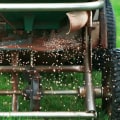Springtime is a pivotal period for lawn care, marking the transition from the dormant winter months to the growth-promoting warmth of spring. As the days lengthen and temperatures rise, your lawn awakens and demands attention to ensure it thrives throughout the growing season. The first step in spring lawn care is to clean up any debris, leaves, or branches that have accumulated over the winter. This not only tidies up your lawn but also allows sunlight, air, and water to reach the grass roots more effectively, promoting healthy growth. Following cleanup, it's essential to assess your lawn for signs of damage or disease, such as dead spots, thatch buildup, or moss, which may require specific treatments like reseeding, dethatching, or applying moss killer.
Aeration is another critical task for spring lawn care. Over time, soil can become compacted, especially in high-traffic areas, making it difficult for air, water, and nutrients to penetrate the soil and reach the grass roots. Aerating the lawn, which involves making small holes in the soil, alleviates compaction and enhances root growth, improving the overall health and vigor of your lawn. This process creates an ideal foundation for overseeding, which can fill in bare spots and improve the density and color of your lawn. Choosing the right seed mix that matches your existing lawn and local climate conditions is crucial for successful overseeding.
Fertilization is a key component of spring lawn care, providing essential nutrients that support growth and greenness. A slow-release fertilizer applied in the spring can nourish your lawn throughout the growing season. However, it's important to follow the recommended application rates and timing to avoid over-fertilization, which can harm your lawn and the environment. Additionally, implementing an effective weed control strategy early in the season can prevent weeds from competing with your grass for space, light, and nutrients. Pre-emergent herbicides can be particularly useful for controlling annual weeds before they have a chance to germinate and establish.
Watering is, of course, a fundamental aspect of lawn care, and spring is the perfect time to consider a lawn irrigation installation. A properly designed lawn irrigation installation ensures that your lawn receives a consistent and adequate amount of water, which is essential for sustaining healthy growth. This system can be especially beneficial during periods of low rainfall or for larger lawns where manual watering is impractical. An irrigation system can be set to water your lawn at the optimal times, usually early in the morning, to minimize evaporation and ensure that water penetrates deeply into the soil. This promotes deep root growth, making your lawn more drought-resistant and healthy.
In addition to these core tasks, spring lawn care should also include regular mowing with a properly maintained mower. Adjusting the mower to the correct height for your grass type encourages healthy growth and helps prevent weeds from taking hold. Leaving grass clippings on the lawn can provide a natural mulch, returning nutrients to the soil as they decompose. Finally, monitoring your lawn throughout the spring and into the summer allows you to quickly address any issues that arise, such as pests or diseases, ensuring that your lawn remains a lush, vibrant green space.






